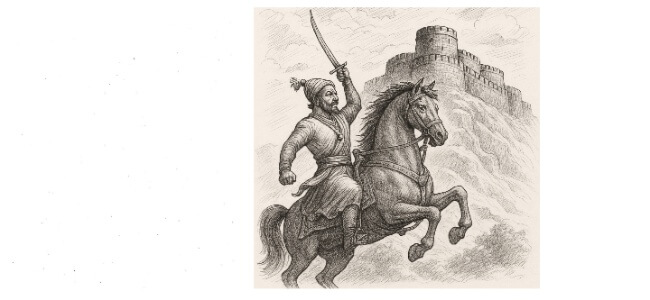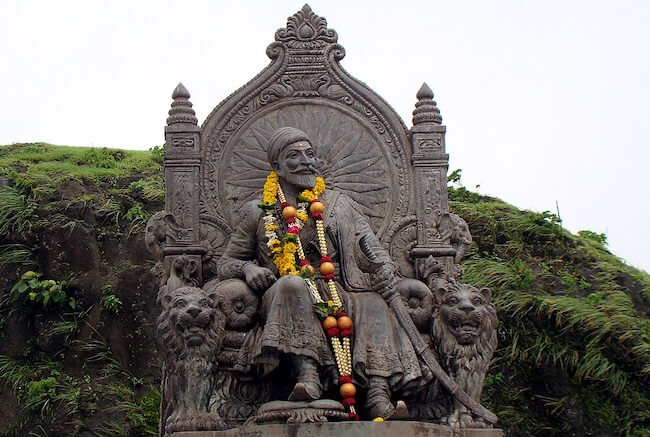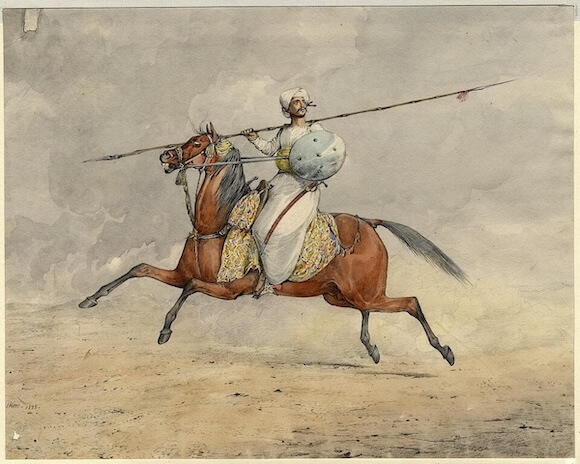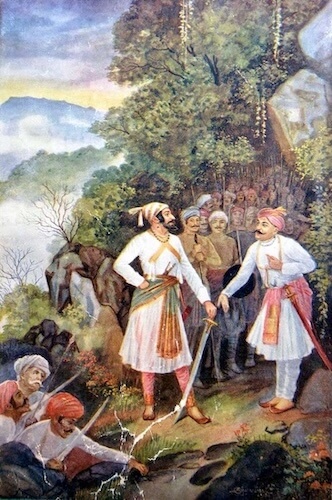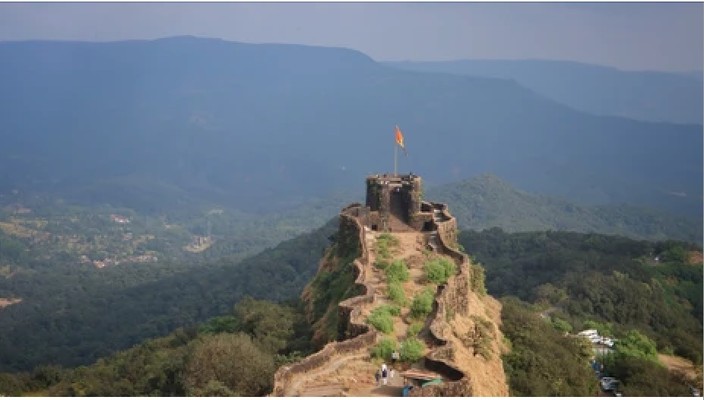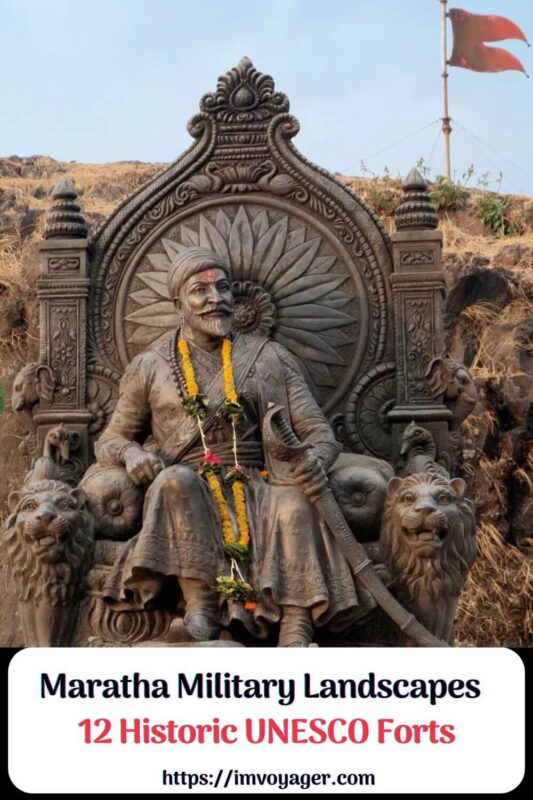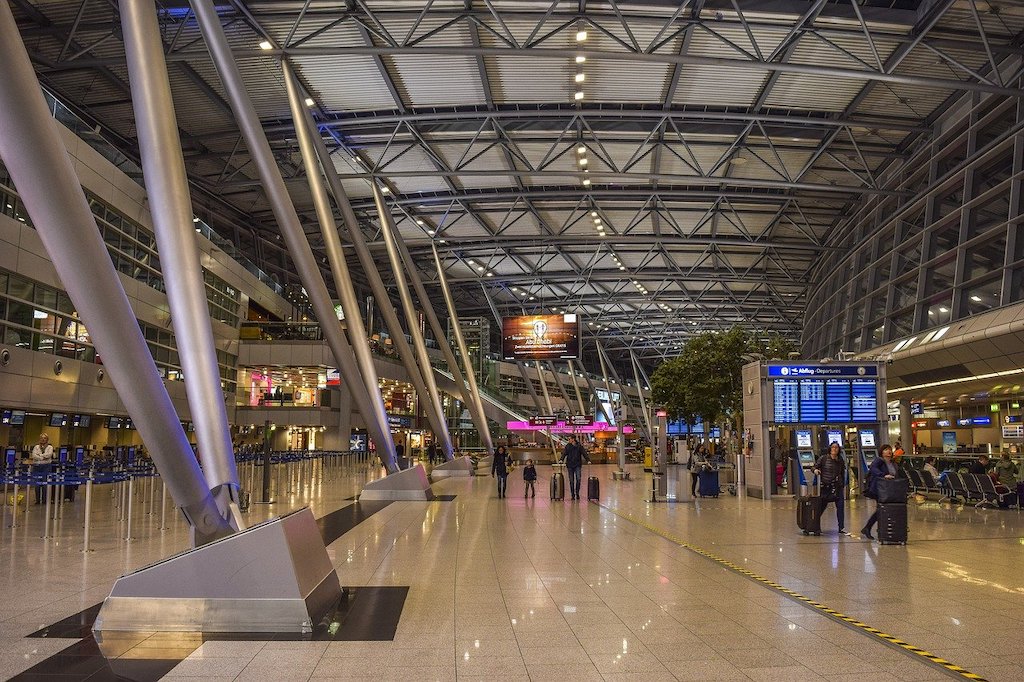India’s historical narrative is incomplete without mentioning the legacy of its formidable forts—structures that served as both architectural marvels and strongholds of resistance. Among these, the forts built by the Marathas stand out for their strategic brilliance, rugged beauty, and deep-rooted cultural significance. These aren’t just ruins of the past; they are echoes of an empire that resisted mighty forces and defended its land with unmatched courage. In recognition of their historical, architectural, and cultural value, UNESCO has included them in its prestigious list of World Heritage Sites.
The Maratha Military Landscapes of India, a UNESCO World Heritage Site, stand as a symbol of the resilience of the Maratha Empire and the valour of its kings. These landscapes consist of 12 incredible forts that resonate with the fearless heroism of the brave men and women who once walked the ramparts of these majestic structures. Each fort tells a story—not just of war and defense—but of identity, strategy, and a fiercely independent spirit. Together, they form a timeless tribute to the Marathas’ military ingenuity and their deep connection with the land they fiercely protected.
Table of Contents
Fortresses of Valour – Forts Of The Maratha Empire
The Maratha Empire, founded in the 17th century by Chhatrapati Shivaji Maharaj, rose to prominence as a formidable force in Indian history. Emerging from the Deccan Plateau, the Marathas established a vast empire that challenged the Mughal dominance and later resisted British colonial expansion. Known for their guerrilla warfare tactics, strong regional governance, and vibrant military tradition, the Marathas fostered a sense of self-rule and cultural pride. At its height, the empire stretched from Tamil Nadu in the south to Peshawar in the north. The Shivaji Maharaj forts stand as enduring symbols of his visionary leadership, strategic brilliance, and the indomitable spirit of the Maratha Empire.
Maratha Military Landscapes of India | Maratha Forts
The Marathas are believed to have constructed or significantly fortified approximately 300 to 350 forts during their reign, though figures may vary depending on the inclusion of restored or tactically occupied sites. Renowned citadels such as Raigad, Pratapgad, Sinhagad, Rajgad, and Shivneri emerged as enduring emblems of Maratha martial excellence. Chhatrapati Shivaji Maharaj alone is credited with the construction or refurbishment of over a hundred forts, strategically positioned across the formidable landscapes of the Western Ghats and Deccan Plateau. These architectural bastions played a pivotal role in the Maratha Empire’s guerrilla warfare, defensive strategy, and decentralised administrative governance.
Shivaji Maharaj Forts – Legacy of Courage and Strategy | Maratha Military Forts
The Shivaji Maharaj forts are not just architectural wonders—they are living monuments to the Maratha Empire’s fearless spirit and military genius. Each fort, from the rugged heights of Raigad to the coastal bastion of Sindhudurg, echoes the legacy of Chhatrapati Shivaji Maharaj’s vision, resilience, and unmatched strategic foresight. These Maratha forts in Maharashtra were not merely defense structures, but bold statements of Swarajya—built to unite, protect, and inspire generations.
They form a vital part of the larger network of Maratha military forts in India, showcasing sophisticated planning, use of terrain, and decentralized fort architecture. Exploring them is like walking through pages of history, where every stone speaks of valor, sacrifice, and a deep love for the motherland. A visit to these forts is more than a journey—it’s a tribute to one of India’s greatest warrior kings and the enduring strength of his empire.
12 Impregnable Citadels – Maratha Military Landscapes of India
12 of the many forts that were built by the Marathas have been inscribed as UNESCO World Heritage Sites, under the group, Maratha Military Landscapes of India. The ensemble encompasses twelve monumental fortifications, chiefly located in the state of Maharashtra, with a singular outpost in Tamil Nadu. These citadels—exemplified by Raigad, Shivneri, and Sindhudurg—were meticulously constructed, modified, or augmented by the Marathas between the late seventeenth and early nineteenth centuries.
Strategically sited amidst precipitous highlands and along vital coastal frontiers, they constituted an elaborate and formidable military architecture that fortified Maratha ascendancy, safeguarded maritime commerce, and ensured dominion over contested territories. Collectively, this network of forts was central to the consolidation of Maratha power and their ascent as a preeminent military and political force in the Indian subcontinent.
Salher Fort – Maratha Military Landscapes of India
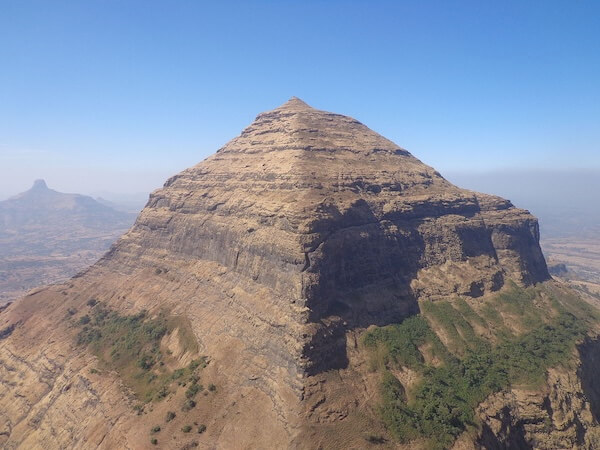
Salher Fort, located in Maharashtra’s Nashik district, is one of the highest forts in the Sahyadri range and holds immense historical significance. Standing at 5,175 feet above sea level, it commands panoramic views of the surrounding terrain. Salher was the site of the famed 1672 battle between the Marathas and the Mughals, where Shivaji’s forces secured a resounding victory. This triumph marked a turning point, asserting Maratha military strength. The fort features rock-cut steps, cisterns, temples, and remnants of military architecture. Its remote grandeur and storied past make Salher a symbol of Maratha resilience and strategic brilliance in mountain warfare.
Shivneri Fort – Maratha Military Landscapes of India
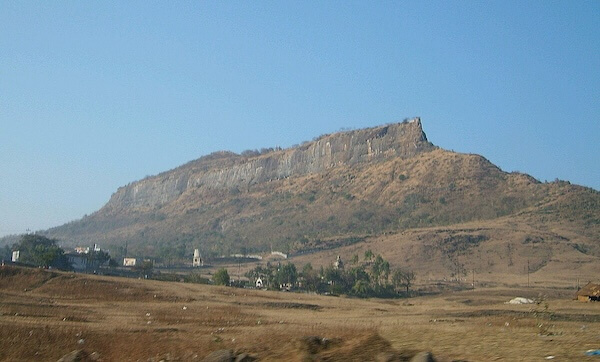
Shivneri Fort, located near Junnar in Maharashtra, is renowned as the birthplace of Chhatrapati Shivaji Maharaj, the founder of the Maratha Empire. Perched atop a steep hill, the fort dates back to the 1st century CE and was later fortified during the Yadava and Bahmani periods. Its strategic location offered natural defence and control over the trade routes of the Deccan. The fort features strong stone walls, a chain-gate entrance, water tanks, and a temple of Goddess Shivai Devi, after whom Shivaji was named.
The Shivai Devi Temple is modest but holds deep spiritual and historical significance. It is considered the fort’s spiritual heart and remains a place of devotion for visitors. Nearby, there is also a small statue of young Shivaji with his mother Jijabai, symbolising the values and vision that shaped his early life. Steeped in history and legend, Shivneri stands as a proud symbol of Maratha heritage and valour.
Lohagad Fort – Maratha Military Landscapes of India
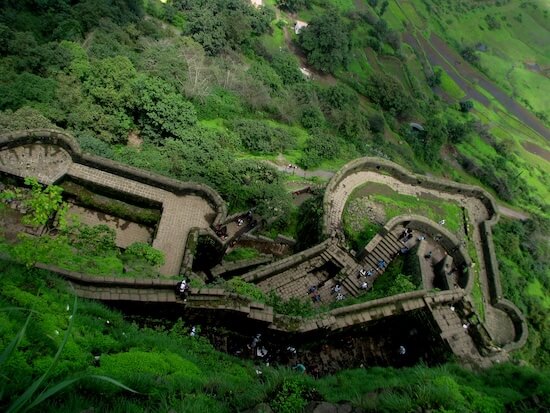
Lohagad Fort, meaning “Iron Fort,” is a majestic hill fort located near Lonavala in Maharashtra’s Western Ghats. Standing at about 3,400 feet, it was strategically important due to its commanding views of the surrounding valleys and trade routes. The fort has a long history, having been used by various dynasties, including the Satavahanas, Chalukyas, and Mughals, before being captured by Chhatrapati Shivaji Maharaj in 1648. Lohagad is renowned for its massive stone gates, sturdy ramparts, and the spectacular Vinchukata (Scorpion’s Tail) rampart extension. Surrounded by lush greenery and misty hills, it is a popular destination both for those interested in heritage and history as well as avid trekkers and nature enthusiasts.
Raigad Fort – Maratha Military Landscapes of India
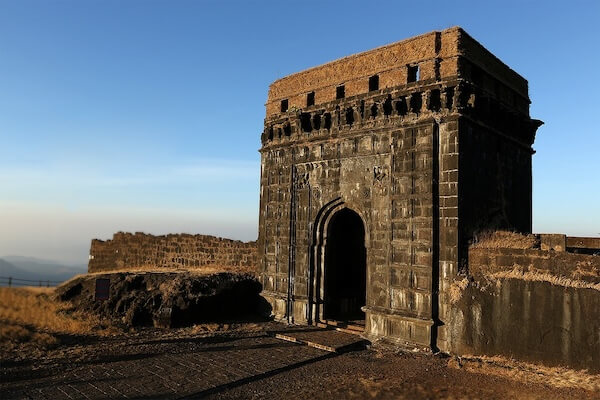
Raigad Fort, perched 2,700 feet above sea level in the Sahyadri range of Maharashtra, served as the capital of the Maratha Empire under Chhatrapati Shivaji Maharaj. Strategically located and nearly inaccessible from three sides, it was chosen by Shivaji for its defensive strength. In 1674, he was crowned here as the first Chhatrapati of the Marathas. The fort complex includes royal chambers, public durbar, granaries, water tanks, and the iconic Maha Darwaja.
Chhatrapati Shivaji Maharaj died at Raigad Fort on April 3, 1680. Raigad, which served as the capital of the Maratha Empire, was not only the seat of his coronation in 1674 but also the place where he spent his final years ruling and consolidating his kingdom. The Samadhi of Shivaji and a statue marking his coronation site stand as solemn reminders of his legacy. Raigad remains a symbol of Maratha pride and sovereignty.
Rajgad Fort – Maratha Military Landscapes of India
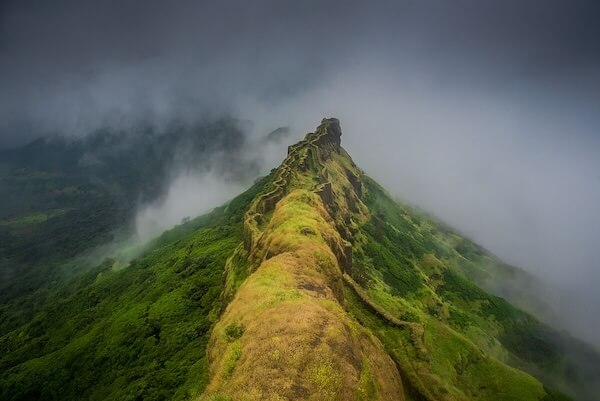
Rajgad Fort, located in the Sahyadri range of Maharashtra, served as the first capital of the Maratha Empire under Chhatrapati Shivaji Maharaj. Perched at 4,300 feet, it is known for its massive size, complex architecture, and natural defences. Originally called Murumbdev, it was renamed Rajgad after Shivaji made it his seat of power. The fort witnessed several key events, including Shivaji’s early military campaigns and the birth of his son, Rajaram. It houses palaces, water cisterns, temples, and watchtowers. Surrounded by deep valleys and rugged terrain, Rajgad is both a symbol of Maratha resilience and a popular trekking destination today.
Pratapgad Fort – Maratha Military Landscapes of India
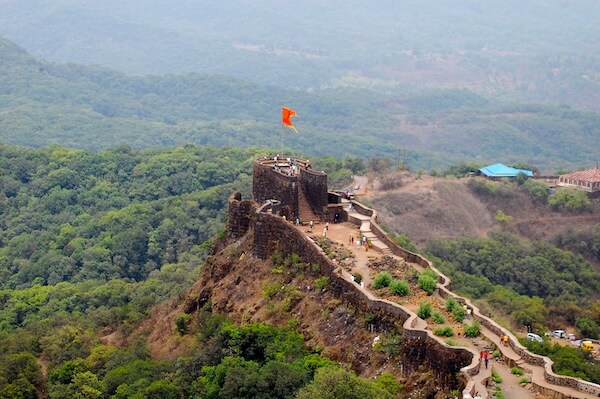
Perched amidst the verdant expanse of the Western Ghats, Pratapgad Fort stands as a formidable sentinel of Maratha valour and resilience. Commissioned by Chhatrapati Shivaji Maharaj in 1656, the fort commands sweeping views of the surrounding valleys and dense forests. It is famed as the site of the legendary encounter between Shivaji and Afzal Khan—an event etched in the annals of Indian history. The fort’s imposing bastions, winding pathways, and the revered Bhavani Temple within its precincts reflect a fusion of strategic brilliance and spiritual significance, making Pratapgad not merely a stronghold but a symbol of indomitable courage and heritage.
Panhala Fort – Maratha Military Landscapes of India
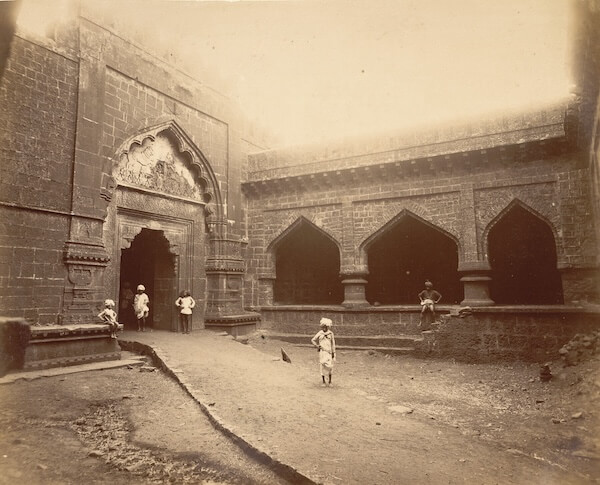
Majestically crowning the Sahyadri ranges near Kolhapur, Panhala Fort is a timeless icon of Maratha endurance and strategic acumen. Steeped in history, it served as a key bastion for Chhatrapati Shivaji Maharaj, who famously orchestrated his daring midnight escape from this very citadel. With its massive ramparts, hidden passages, and intricate bastions, Panhala reflects centuries of architectural ingenuity and military foresight. The fort’s commanding position offers panoramic views of lush valleys, while structures like the Andhar Bavadi (hidden well) whisper tales of intrigue and survival. Panhala stands today not just as a fortress, but as a silent narrator of Maratha glory.
Vijaydurg Fort – Maratha Military Landscapes of India
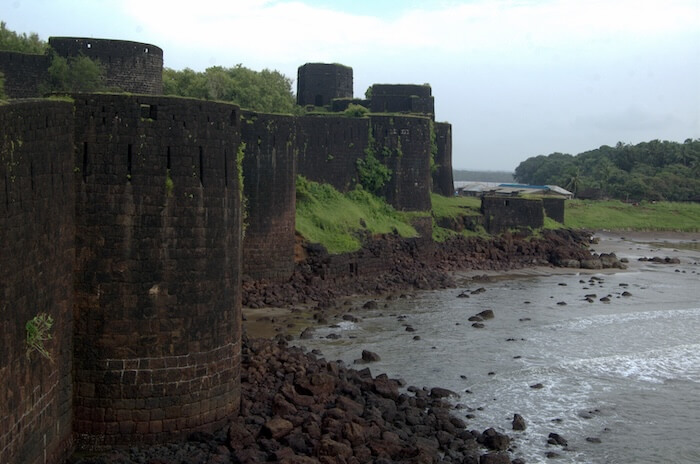
Vijaydurg Fort, majestically situated along the rugged Konkan coastline, stands as a magnificent symbol of maritime might and strategic mastery. Often hailed as the “Gibraltar of the East,” this formidable sea fort was significantly strengthened by Chhatrapati Shivaji Maharaj to guard against foreign naval incursions. Encircled by the Arabian Sea on three sides and fortified by towering laterite walls, the fort exemplifies military ingenuity, with hidden underwater trenches and complex bastions. Its storied past resonates with tales of naval prowess, particularly under the Maratha admiral Kanhoji Angre. Vijaydurg remains an enduring sentinel, echoing the glory of a seafaring empire.
Suvarnadurg Fort – Maratha Military Landscapes of India
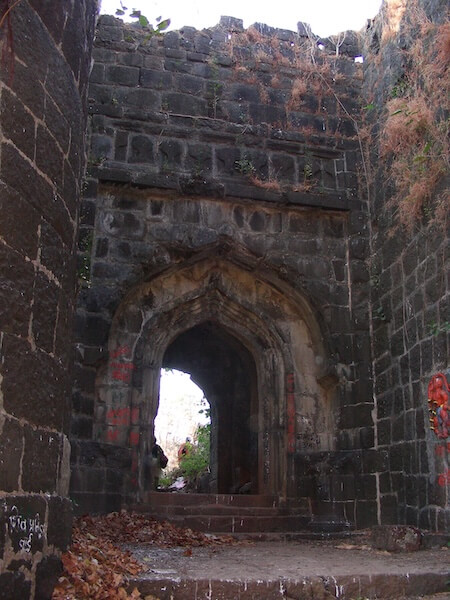
Suvarnadurg Fort, poised regally upon a rocky islet off the Konkan coast, is a gleaming relic of Maratha naval supremacy. Established by Chhatrapati Shivaji Maharaj to command the Arabian Sea, it formed a vital link in the coastal defense network. The fort’s name—literally meaning “Golden Fort”—evokes both its strategic importance and its former grandeur. Accessible only by boat, Suvarnadurg was once an impregnable bastion, reinforced under the vigilant command of Admiral Kanhoji Angre. Surrounded by turbulent waters and fortified by robust laterite walls, it stands as a stoic guardian of Maratha maritime legacy, whispering tales of valor, vigilance, and sovereignty.
Sindhudurg Fort – Maratha Forts In India
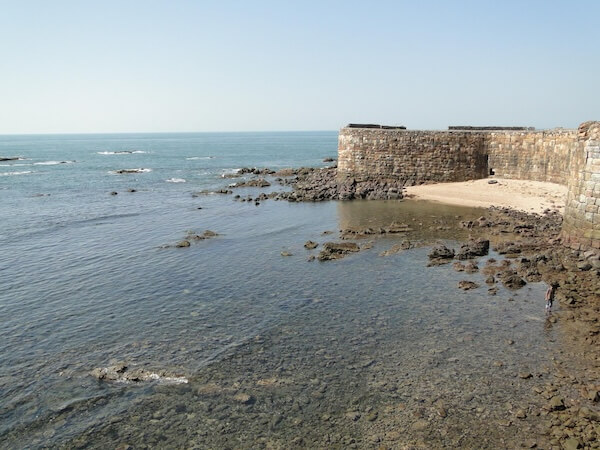
Sindhudurg Fort, majestically rising from the azure waters of the Arabian Sea, is a sublime testament to Chhatrapati Shivaji Maharaj’s naval vision and architectural prowess. Constructed in 1668 on the rocky island of Kurte, this imposing sea fort was designed to thwart foreign invasions and establish Maratha supremacy along the western coast. Its massive laterite ramparts, concealed entrances, and intricate design reflect extraordinary engineering acumen. Within its fortified embrace lies a rare temple dedicated to Shivaji himself—a shrine to the warrior-king. Encircled by endless waves, Sindhudurg remains an enduring symbol of maritime strength, cultural pride, and sovereign ambition.
Khanderi Fort – Maratha Forts In India
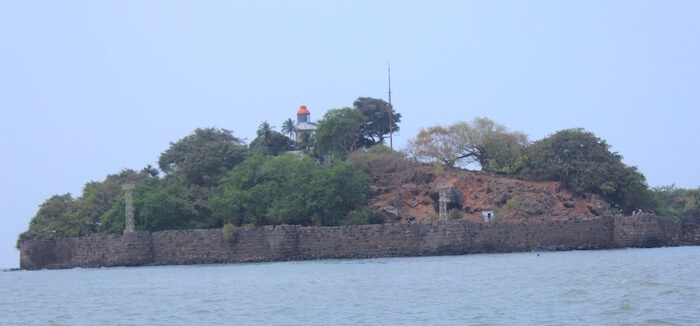
Khanderi Fort, known as Kanhoji Angre Island, stands resiliently in the Arabian Sea, just off the coast of Maharashtra near Mumbai. Built in the 17th century by the Marathas under Chhatrapati Shivaji Maharaj, it played a pivotal role in coastal defence and naval strategy. Named after the great Maratha admiral Kanhoji Angre, the fort features ramparts, bastions, cannons, and a functioning lighthouse that adds to its maritime legacy. It served as a strategic outpost, resisting British and Portuguese incursions. Surrounded by turbulent waters, Khanderi remains a striking symbol of Maratha naval prowess and enduring heritage along the Konkan coast.
Gingee Fort – Maratha Forts In India
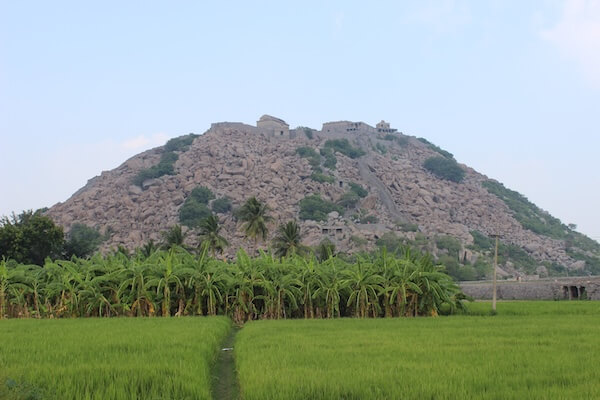
Gingee Fort, often hailed as the “Troy of the East,” rises dramatically from the rugged landscape of Tamil Nadu, exuding an aura of ancient might and resilience. Perched atop three isolated hills—Krishnagiri, Rajagiri, and Chandrayandurg—the fort complex is a marvel of military architecture, blending natural defenses with strategic brilliance. Originally built by the Cholas and later fortified by successive dynasties, including the Vijayanagara Empire and the Marathas, Gingee withstood formidable sieges, even earning admiration from the British. Its towering granaries, citadels, and secret passages whisper tales of valour, making it a proud sentinel of South India’s storied past and indomitable spirit.
These timeless fortresses stand as enduring symbols of Maratha glory, echoing tales of courage, resilience, and architectural brilliance. Being inscribed as UNESCO World Heritage sites only enhances their appeal and puts them on the global tourist map of India. The silent songs of valour that these timeless structures resonate with are sure to inspire future generations and keep India’s rich heritage alive.
Did you enjoy reading our post on Maratha Military Landscapes of India? These mighty forts are more than just stone and strategy—they are echoes of bravery, resilience, and the extraordinary legacy of the Marathas.
Have you visited any of the legendary Maratha forts like Raigad, Sinhagad, or Pratapgad? What was your experience like—did the history give you goosebumps? Did the sweeping views take your breath away? We would love to hear all about your experience of visiting the Maratha forts in the comments below!
If this post about Maratha forts stirred your curiosity or brought back fond memories of your travels, do share it with your friends and family—especially those who love history, architecture, or adventure. And don’t forget to post it on your social media too. Let’s keep the stories of these monumental forts alive by sharing them far and wide.
We are sure you found the glimpses into the legacy of Maratha forts inspiring. If you are hungry for more such fascinating explorations, subscribe to our blog and monthly newsletter for travel stories, cultural insights, and hidden gems across India.
Follow us on social media for real-time travel tales, updates, and more stories from the road. The journey does not end here—the next adventure is just a click away!
Also read:
Chhatrapati Shivaji Maharaj Quiz | 76 Best Questions & Ans.
Chhatrapati Shivaji Maharaj Quotes – English & Hindi
Where Every Journey Begins, and the Soul Finds Its Wings
Close your eyes and breathe in the scent of possibility. Picture golden shores that shimmer like stardust, mountains wrapped in drifting mist, and ancient cities whispering stories through time. This isn’t just travel—it’s soulcraft. At ImVoyager, we don’t just plan trips; we curate soulful odysseys—love letters to the world, penned in footsteps and sunsets. From hidden gems to timeless trails, every journey dances to the rhythm of you.
Let your wanderlust unfold. Write to us at imvoyager18@gmail.com — your next extraordinary escape awaits.
Moments, Not Just Miles
A journey doesn’t begin at the airport—it begins in a quiet spark, a longing, a dream. Step into our world of handpicked inspiration: secret stays, heartwarming encounters, and places that awaken something within. Whether it’s the hush of a misty mountain, temple bells at dawn, or laughter echoing down a cobbled lane—you’ve found your tribe.
Subscribe, and let your spirit wander—even when your passport rests.
From Screen to Soul: Travel With Sandy & Vyjay
Welcome to Travel With Sandy & Vyjay—where every story opens a door to the extraordinary. Walk through vibrant bazaars, listen to ancient chants at sunrise, and breathe in the wonder of places that linger in your heart. No boarding pass needed. Just Wi-Fi, an open heart, and a thirst for discovery.
More Than a Blog — A Global Tribe
Voyager is more than a travel site. It’s a gathering place for explorers, storytellers, and soulful wanderers. Join us on Instagram, Facebook, X (Twitter), LinkedIn, and YouTube. Want fresh updates with your morning chai? Subscribe to Voyager Travel Bytes on WhatsApp or email. Follow us on Instagram—where our stories never stop unfolding.
Your Story. Your Soul. Your Way.
Are you a dreamer who finds joy in the silence of backroads? A seeker of dawns atop faraway peaks? Or a poet who reads verses etched in old stones? We craft journeys that reflect who you are—each one curated like a canvas, every route echoing with meaning. Because the best journeys don’t just show you the world—they reveal who you’re meant to be.
The World Is Whispering — Will You Answer?
A world of wonder calls—full of moments that become memories, and paths that lead to transformation. Reach out at imvoyager18@gmail.com and let’s co-create a journey that stays with you long after the footprints fade.
Because travel isn’t just about where you go.
It’s about who you become along the way.
The first step? Just whisper… “We’re ready.”
We are a reader-supported site. This means, at no additional cost to you, we may earn a small commission if you book a flight or hotel, or make a purchase through one of our affiliate links. Thank you for your support!
Flights – Air India (Domestic) or Air India (International), or Priceline
Tours – Click to book top tours around the world. Book tours and activities here.
Experiences – Book your next unforgettable experience here, with flexible bookings and free cancellations. Reserve tours and activities now and pay later.
Hotels – Click to book the best hotels/resorts. Choose the best stay options with TripAdvisor or Hotels.com, or HotelsCombined
Travel Insurance – Click to book Travel Insurance that covers a range of travel insurance and safety services including medical emergencies, lost luggage, trip cancellation and more
Visas and Travel Documents Application – Click here for Online Travel Visa Check
Online Passport Photo – Get Your Passport Photo Online here

Do You Love Traveling?
Do you want to know how to travel the world? We have put together a very useful travel resources page with the best travel tips. Go check it out now. Thanks for visiting our site Voyager - imvoyager.com and taking the time to read this post! If you wish to collaborate/work with us then reach us at imvoyager18@gmail.com We’d love it if you’d comment by sharing your thoughts on this post and share this post on social media and with your friends. Follow our journey on our social media channels: Facebook X Instagram Pinterest YouTube
Start dreaming about your next adventure with Tripadvisor. Book your next unforgettable experience here with flexible bookings and free cancellations.
Flight booking online at the best fare
60+ Million Users Trust TripAdvisor With Their Travel Plans. Shouldn't You?
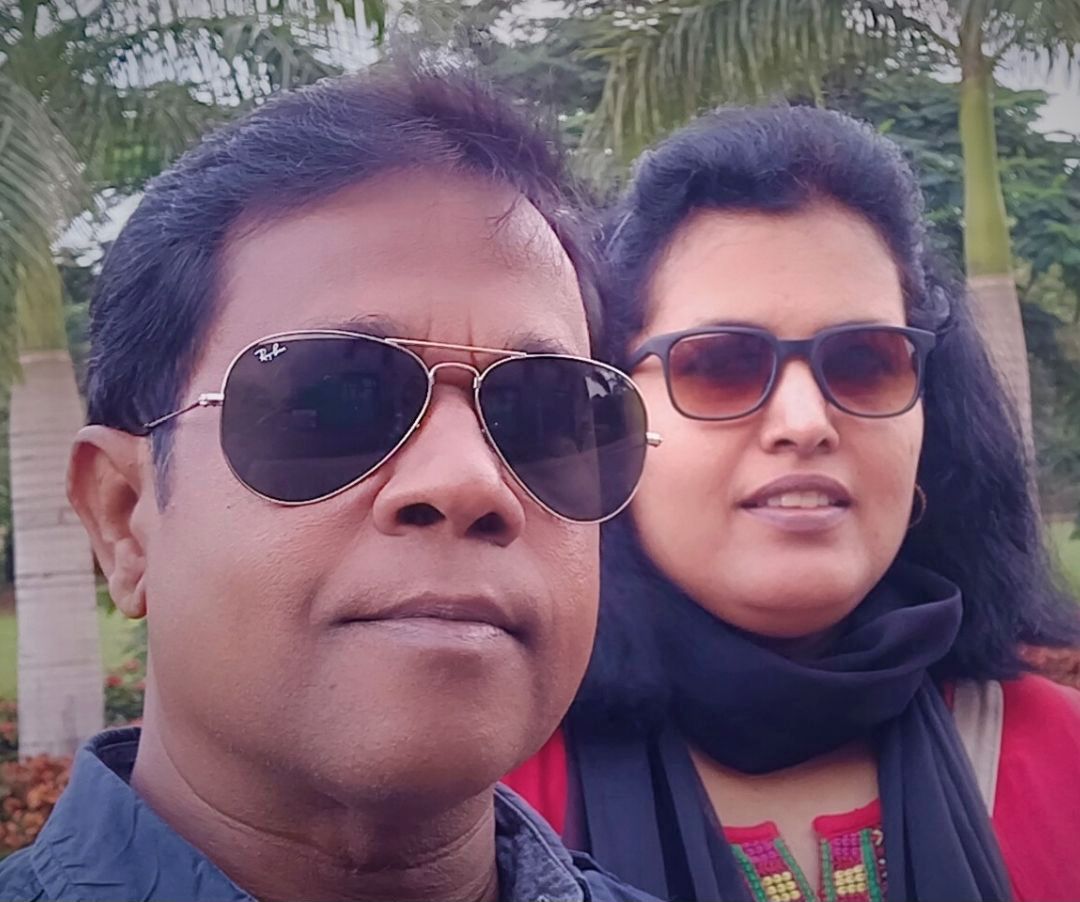
Sandy & Vyjay are a husband and wife duo who are travel content creators. They are co-founders of this travel website and are one of the leading travel content creators in India.
Sandy & Vyjay quit their successful corporate careers to pursue their passion for travel and writing full-time. Their dedication has earned them the “Best Travel Writer” award and numerous accolades on both national and international stages. Focusing on India’s destinations, heritage, and culture, they are passionate advocates for nature and the environment. Through their content, they promote ecotourism and sustainable travel, inspiring others to explore and preserve the beauty of India.
